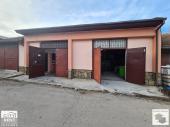|
News
| Veliko Tarnovo renovating historic train station to make Trapesitsa fortress accessible for tourists. |
|
Friday, Jan 22, 2016 |
|
The city of Veliko Tarnovo in Central North Bulgaria is about to complete the renovation of the Trapesitsa Train Station, a historic place which is also the key to making the Trapesitsa Fortress, one of the two citadels (together with the Tsarevets Hill Fortress) of the late medieval Bulgarian capital Tarnovgrad, accessible for tourists.
The reconstruction of the long dilapidated Trapesitsa Train Station started at the end of summer 2015, after Veliko Tarnovo Mayor Daniel Panov insisted on it before Bulgariaís Transport Ministry, Veliko Tarnovo Municipality has said in a statement.
The renovation is being performed by Bulgariaís National Railroad Infrastructure Company, a state-owned enterprise. It is supported to restore the original appearance and functions of the Trapesitsa Train Station from 108 ago.
The Trapesitsa Train Station is a historic place in itself. This is where on September 22, 1908, celebrated todayís as Bulgariaís Independence Day, then Bulgarian ruler Knyaz (King) Ferdinand I (r. 1887-1918) arrived in order to reach the medieval Holy Forty Martyrsí Church located nearby.
After Bulgariaís National Liberation from the Ottoman Empire in 1878 recognized by Europeís Great Powers under the Berlin Treaty, Bulgaria was not fully independent; the so called Principality of Bulgaria was autonomous within the Ottoman Empire.
After in the early fall of 1908, Austria-Hungary decided to violate the Berlin Treaty by continuing its occupation of Bosnia and Herzegovina (which had been leased to it back in 1878 for a period of 30 years), the Bulgarian government took advantage of the situation and declared the independence of Bulgaria as a Tsardom (technically meaning an ďempire", a successor to the medieval Bulgarian Empire), and upgraded Ferdinandís title to ďTsar" (i.e. ďemperor").
The Holy Forty Martyrsí Church is known for a victory inscription of Tsar Ivan Asen II (r. 1218-1241 AD) from the Second Bulgarian Empire (1185-1396 AD) and for housing the grave of Tsar Kaloyan (r. 1197-1207 AD).
This is why in 1908, Knyaz (King) Ferdinand I arrived at the Holy Forty Martyrsí Church in the late medieval Bulgarian capital Veliko Tarnovo (Tarnovgrad) in order to pronounce there a declaration of independence from the Ottoman Empire.
In addition to this historic significance of the Trapesitsa Train Station, it is also supposed to become the starting point from which tourists visiting the soon to be partly restored Trapesitsa Hill Fortress will begin their tours.
The train station is going to be fully reconstructed within weeks. The first station of the funicular, i.e. a cable railway with which tourists will climb up to the Trapesitsa Hill Fortress, has already been constructed.
Once the renovation is completed, the Trapesitsa Train Station will not only become fully operational once again but it will also be granted the status of a monument of culture of national importance.
The Trapesitsa Train Station is a historic building in itself because of its connection with Bulgariaís recent history Ė the declaration of independence from the Ottoman Empire in 1908. Photo: Veliko Tarnovo Municipality
The ongoing archaeological restoration of the Trapesitsa Fortress in the city Veliko Tarnovo, the capital of the Second Bulgarian Empire (1185-1396 AD) in the Middle Ages, is being carried out by Veliko Tarnovo Municipality with EUR 1.2 million donated by the Heydar Aliyev Foundation of the government of Azerbaijan.
However, the partial archaeological restoration of the Trapesitsa Hill has been criticized by independent journalists because of the human rights and media freedom record of Azerbaijanís President Ilham Aliyev.
The recent archaeological excavations on the Trapesitsa Hill started in 2006, and since then the Bulgarian archaeologists have found there a total of 21 medieval churches, a monastery, and a set of civilian and military buildings.
As the Trapesitsa Fortress is presently being partly restored, the archaeologists continue to excavate and research various sections of one of the two major strongholds inside the late medieval Bulgarian capital.
For example, archaeologist Deyan Rabovyanov and his colleague Plamen Doychev have unveiled a 3D model of the southernmost residential quarter of Trapesitsa at the end of the 14th century. |
|
|
Source:
archaeologyinbulgaria.com
|
|
|
|
|
| » RENTALS |

|
|
|
| Commercial |
€ 500 |
|
| Location: |
Gorna Oryahovica |
|
|

|